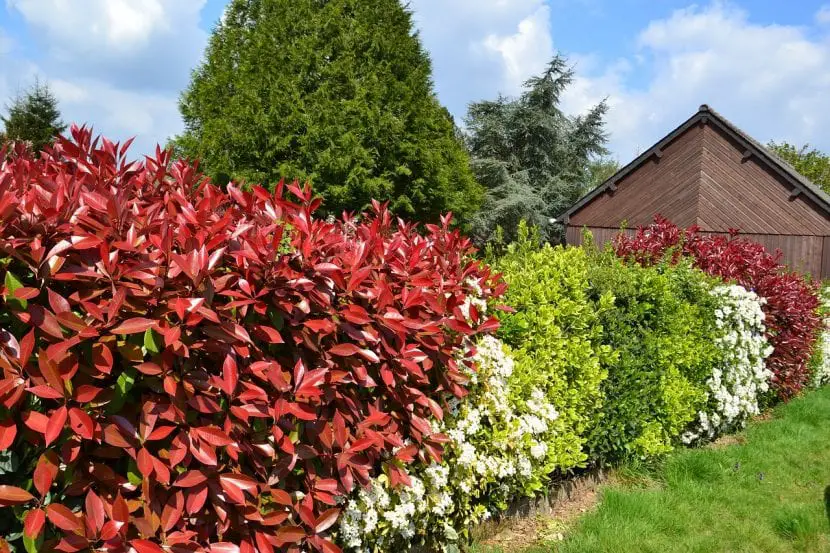
A hedge is an element that all gardens must have. Not only can they be very decorative, but they also allow us to have the different corners separated by a natural barrier formed by resistant and beautiful plants.
It is relatively easy to get one; in fact, depending on how long we want it to be, it can be finished in a few hours. So let’s see how to create a hedge step by step.
What type of hedge do you need?

It is very important to know what type of hedge we need to properly choose the species that will form it. Depending on the height we want it to reach, we can have:
- Tall hedges or screens: reach a height of more than 2 meters.
- Species:
- birch hornbeam (hornbeam): it is a deciduous tree very resistant to frost, perfect for temperate climates. See file.
- Cupressus (cypress): it is a classic of the hedges. There are different species, such as the Cupressus sempervirens or Cupressus macrocarpa. Any of them will give us that privacy that is so much needed in the garden.
- nerium oleander (oleander): it is a shrub that produces so many flowers that it is a joy to see it. Ideal for warm and temperate climates. See file.
- Species:
- Medium hedges: they reach between 1 and 2 meters in height.
- Species:
- I unite the trees (strawberry tree): although it has a slow growth, it is very interesting as a hedge. It resists light frosts and, as if that were not enough, it produces edible fruits. See file.
- Buxus sempervirens (boxwood): it is a plant that is widely used to make formal hedges. It is grown in temperate regions of the world. See file.
- Chaenomeles japonica (Japanese quince): it is a deciduous shrub that produces very pretty flowers in spring. Like boxwood, it is grown in temperate climates.
- Species:
- Low hedges: they reach between 0,5 and one meter in height.
- Species:
- Abelia x grandiflora: with it you can make free hedges with flower. It is a highly recommended option to have, for example, as a hedge next to the wall of the house.
- Berberis thunbergii ‘Atropurpurea’ (barberry): it is a deciduous shrub with small but beautiful purple leaves that withstands the cold without being damaged.
- Rosa sp: shrub rose bushes, such as those of the Floribunda or Grandiflora type, are used to make informal hedges of extraordinary beauty. See file.
- Species:
- Borders: reach less than 0,5 meters in height.
- Species:
- cineraria maritime (gray cineraria): it is an evergreen bush formed by a very attractive silver foliage. It is a plant that is also very resistant, capable of withstanding intense frosts. See file.
- Lavandula angustifolia (lavender): it is an evergreen shrub with which you can get a very decorative and low-maintenance hedge. See file.
- Frutical potentilla (Cincoenrama): it is a deciduous shrub that produces yellow flowers during the summer. Very resistant to pests and diseases.
- Species:
Prepare the ground

Once we have chosen the plants we want to plant, we have to prepare the ground, that is, we must remove wild herbs, fertilize and level the soil. To make it easier and more comfortable for us, if it is going to be a rather large hedge, a walking tractor; On the other hand, if it is going to be rather small, with a hoe we will do the job much better.
When we have it clean and level, we will delimit the area with a rope or polestaking into account the shape we want the hedge to have. In this way, we will know where exactly we have to plant each of the plants.
Plant your hedge

Now that everything is ready, it’s time to move on to the part we like the most: planting the plants that will form the hedge. Whether they are very young specimens, such as the one in the image above, or if they are more adult, we have to take into account that we must leave an adequate distance between them. Over the years, if they have been planted closely together, those who are weaker will not be able to do anything against the strongest, and they will die.
Therefore, it is highly recommended that we inform ourselves well before we start planting, because this is the only way we will have to avoid wasting money and time.
Place an anti-weed mesh

To prevent the seeds of wild herbs from germinating, it is highly advisable to put a anti-weed mesh. As we probably do not like this green color very much, we can put decorative stones or pine bark on top.
Has it been useful to you?
